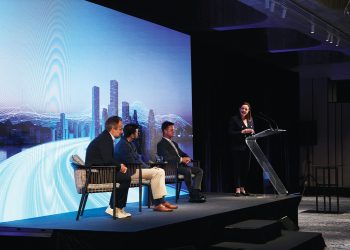Is the sensational search for Amazon’s HQ2 nearing the end? According to various news sources, that may be the case; however, the reported winner—or, rather, winners—is not what bidding cities and consumers across North America were expecting.
Although there hasn’t been formal word from Amazon as of yet (at press time), the New York Times reports the online retail marketplace will be splitting up its second headquarters into two locations: the Crystal City area of Arlington, Va., and the Long Island City neighborhood of Queens, N.Y.
Why these locales? Amazon reportedly has more employees in these two areas than anywhere else outside of Seattle, where the retail giant houses its original corporate headquarters.
What happens to the profitable boost of an estimated $5 billion in investments for the winning city, as well as up to 50,000 high-paying jobs? It’s assumed they’ll be split among the two winning locations—a controversial move that leaves many bidding cities believing Amazon created the contest to heighten an already aggressive environment in which tax incentive packages had to beat out the competition.
So, who’s the true winner? With HQ2 declared to be the “full equal to our current campus in Seattle,” according to Amazon, the reward for these two chosen cities may not be what they were promised. Will Amazon go forward with two “headquarters,” or choose to build satellite offices instead—or, could this be an indication that Amazon has not yet made its decision, and is merely using these headlines as a tactic to increase current incentive packages?
“Even if the most obvious reasons appear to be about attracting more tech workers, the PR and government incentives benefits could help, too,” Jed Kolko, chief economist at Indeed, told the New York Times, stating that local governments “might feel pressure to increase the incentives they are offering Amazon, and the surprise is yet another news cycle for the Amazon headquarters process.”
Of course, if there are two winners, this could be positive news for the real estate industry. Adding 50,000-plus workers over a decade to a single location could have significant adverse impacts on not only transit systems, but on affordable housing, as well. A more manageable influx of Amazon workers, however, could help boost these local economies and real estate markets without overwhelming the areas and causing a housing crisis.
The Data Behind the Search
The year-long search has been a hot topic of conversation across the globe, and recently at the 2018 REALTORS® Conference & Expo, held in Boston, Mass., this past weekend. One session, “Amazon HQ2 and the Future of Site Selection,” featuring K.C. Conway, chief economist for the CCIM Institute, analyzed the site selection process and shared predictions about which location would win out.
Perhaps a more accurate fortune telling than Conway believed, he stated Amazon had missed an opportunity to adapt to today’s modern co-working trend in which a single brick-and-mortar location is not as valuable as having multiple workplaces that promote a remote lifestyle, which would also mean reaping the tax and other incentive benefits of several locations.
“The future is co-working spaces,” said Conway. “Companies are looking at flexibility. It’s an opportunity Amazon missed here, and others are looking at that today.”
Conway’s prediction for the winning city? The Virginia and Washington D.C. area seemed to be a solid choice for Amazon in the past few weeks—a forecast that was on the right track. Early on, Conway pegged other cities such as Pittsburgh, Pa., and Columbia S.C., as wildcards—cities that had a lot of unique amenities to offer, but were not labeled as traditional metro areas to which Amazon would likely flock to.
Conway stated there is a lesson to be learned from this experience. While certain locations are believed to be stable metro areas that can support large infrastructure changes and complex corporate movement, many U.S. cities have enormous, unheard-of potential—but without their participation in bidding schemes such as Amazon’s, corporations and real estate investors will never look at these locations as potential profit centers, automatically losing out on opportunities to boost their local real estate markets.
“Iowa should have competed. It’s within 90 miles of the quad cities, a major center for logistics and trucking…” stated Conway as an example, clarifying that most of the farmer population only utilizes its shipping trucks throughout the farming season, putting them away during October, November and December—prime time for retail giants like Amazon, who are constantly in need of shipping and transport services during the holiday season in order to meet increased consumer demand.
Transit systems were thought to be a major factor in Amazon’s deliberation, which pointed to the winning city being located in the Southeast, according to Conway. Termed the “Southeast Triangle,” Conway said the area produces more GDP than any other region the U.S., and makes up 80 percent of all new corporation builds or corporate expansion projects because of its availability of freight highways, which are not as commonplace in the Western U.S.
Other factors that may have played a role? Conway stated Amazon’s customer base could have been a significant influencer—a year ago, the East Coast had more Amazon customers than the West Coast. Additionally, factors such as home affordability, which were thought to be substantial elements, may have not impacted their decision as heavily as originally assumed.
“Who has the most and least expensive states in the country to build a home?” Conway asked, stating that of the top most affordable cities, only Columbus, Ohio, made Amazon’s top 20 list, while cities such as L.A., Boston and NYC, which were also shortlisted, are among the top most expensive locations for home affordability.
Regardless, site selection will surely change, and Amazon’s recent contest-driven selection process is just the first of many innovative methods to be used in the future.
“If you’re not thinking that in site selection we are replacing the traditional, you’ll miss out completely,” said Conway. “This will be replicated and emulated.”
Continuing coverage of the REALTORS® Conference & Expo to come.
Liz Dominguez is RISMedia’s associate content editor. Email her your real estate news ideas at ldominguez@rismedia.com. For the latest real estate news and trends, bookmark RISMedia.com.











